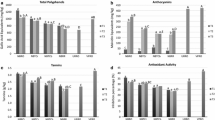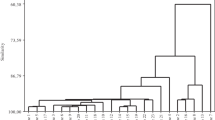Abstract
Anthocyanin and flavonol profiles of Vitis vinifera berry skin have been diffusely studied in past years to identify the effects exerted by climate, environment and cultural practices on their biosynthesis. They have also been used for chemotaxonomic purposes with the aim of classifying grape varieties. Hydroxycinnamates and phenolic acids are the most important group of non-flavonoid phenols in grapes and wines. In the present work six ‘Barbera’ clones were grown in the same site to evaluate the influence of two seasons on the accumulation of flavonoids and hydroxycinnamates at maturity. Berry skins were extracted in an ethanolic buffer and flavonoids and hydroxycinnamates were separated by HPLC. Two principal component analysis (PCA) models were built to identify phenolic parameters exploitable to classify clones. The PCA scores were taken further to perform discriminant analysis to evaluate the degree of classification possible. A significant seasonal variability was observed for most phenolic features, whereas some parameters such as total anthocyanin expressed on a per berry basis, the sum of tri-hydroxylated anthocyanin percentages, the percentages of kaempferol glucuronide and the total hydroxycinnamate content were stable over the seasons. The percentage of individual anthocyanin alone, not associated with maturity data, was not effective in classifying clones; in association with maturity data it allowed to discriminate clones, similarly to what it was previously assessed for classifying varieties. The results indicated that LDA models developed on the PCA scores including maturity data correctly classified 75% of clones.




Similar content being viewed by others
References
Adams DO (2006) Am J Enol Vitic 57:249–256
Ribérau-Gayon P (1964) Ann Physiol Vég 6:211–242
Boss PK, Davies C, Robinson SP (1996) Plant Physiol 111:1059–1066
Bogs J, Ebadi A, McDavid D et al (2006) Plant Physiol 140:279–291
Downey MO, Harvey JS, Robinson SP (2003) Aust J Grape Wine Res 9:110–121
Yamane T, Jeong ST, Yamamoto NG et al (2006) Am J Enol Vitic 57:54–59
Guidoni S, Ferrandino A, Novello V (2008) Am J Enol Vitic 59:22–29
Mazza G, Fukumoto L, Delaquis P et al (1999) J Agric Food Chem 47:4009–4017
Núñez V, Monagas M, Gomez-Cordovés MC et al (2004) Postharvest Biol Technol 31:69–79
Roggero JP, Larice JL, Rocheville-Divore C et al (1988) Rev Fr Oenol 112:41–48
González-Neves G, Gómez-Cordovés C, Barreiro L (2001) J Wine Res 12:125–133
Boulton R (2001) Am J Enol Vitic 52:67–87
Scharbert S, Hofmann T (2005) J Agric Food Chem 53:5377–5384
Montoro P, Braca A, Pizza MP et al (2005) Food Chem 92:349–355
Cheynier V, Rigaud J (1986) Am J Enol Vitic 37:248–252
Price SF, Breen PJ, Valalladao M et al (1995) Am J Enol Vitic 46:187–194
Mattivi F, Guzzon R, Vrhovsek U et al (2006) J Agric Food Chem 54:7692–7702
Castillo-Muñoz N, Gomez-Alonso S, Garcia–Romero E et al (2007) J Agric Food Chem 55:992–1002
Romero I, Sanchez-Ballesta MT, Escribano MI et al (2008) Postharvest Biol Technol 49:1–9
Cortell MJ, Kennedy JA (2006) J Agric Food Chem 54:8510–8520
Singleton VL, Zaya J, Trousdale EK (1986) Phytochemistry 25:2127–2133
Romeyer F, Macheix JJ, Goiffon JP et al (1983) J Agric Food Chem 31:346–349
Falchi M, Bertelli A, lo Scalzo R et al (2006) J Agric Food Chem 56:6613–6622
Di Stefano R, Maggiorotto G (1995) Riv Vitic Enol 2:51–65
Di Stefano R, Cravero MC (1992) Sci Aliment 12:139–144
Brossaud F, Cheynier V, Asselin C et al (1999) Am J Enol Vitic 50:277–284
Cuny M, le Gall G, Colquhoun IJ et al (2007) Anal Chim Acta 597:203–213
Di Stefano R, Borsa D, Bosso A et al (2000) L’Enologo Dic 2000:73–76
Di Stefano R, Mattivi F, Caburazzi M et al (2008) Riv Vitic Enol 1:39–61
Haselgrove L, Botting D, Van Heeswijck R et al (2000) Aust J Grape Wine Res 6:141–149
Bergqvist J, Dokoozlian N, Ebisuda N (2001) Am J Enol Vitic 52:1–7
Spayd SE, Tarara JM, Mee DL et al (2002) Am J Enol Vitic 53:171–182
Downey MO, Dokoozlian NK, Krstic MP (2006) Am J Enol Vitic 3:257–268
Guidoni S, Ferrandino A, Novello V (2007) Italus Hortus 14:199–203
Acknowledgments
Authors thank Dr. Franco Mannini (IVV, CNR, Grugliasco, TO), selector of some of the studied clones, for providing the grapes. For an overview about the agronomic characteristics of clones please refer to: A. Schneider and F. Mannini, ‘Vitigni del Piemonte’, Varietà e cloni, Supplemento n. 50 “Quaderni della Regione Piemonte–Agricoltura”.
Author information
Authors and Affiliations
Corresponding author
Rights and permissions
About this article
Cite this article
Ferrandino, A., Guidoni, S. Anthocyanins, flavonols and hydroxycinnamates: an attempt to use them to discriminate Vitis vinifera L. cv ‘Barbera’ clones. Eur Food Res Technol 230, 417–427 (2010). https://doi.org/10.1007/s00217-009-1180-3
Received:
Revised:
Accepted:
Published:
Issue Date:
DOI: https://doi.org/10.1007/s00217-009-1180-3




